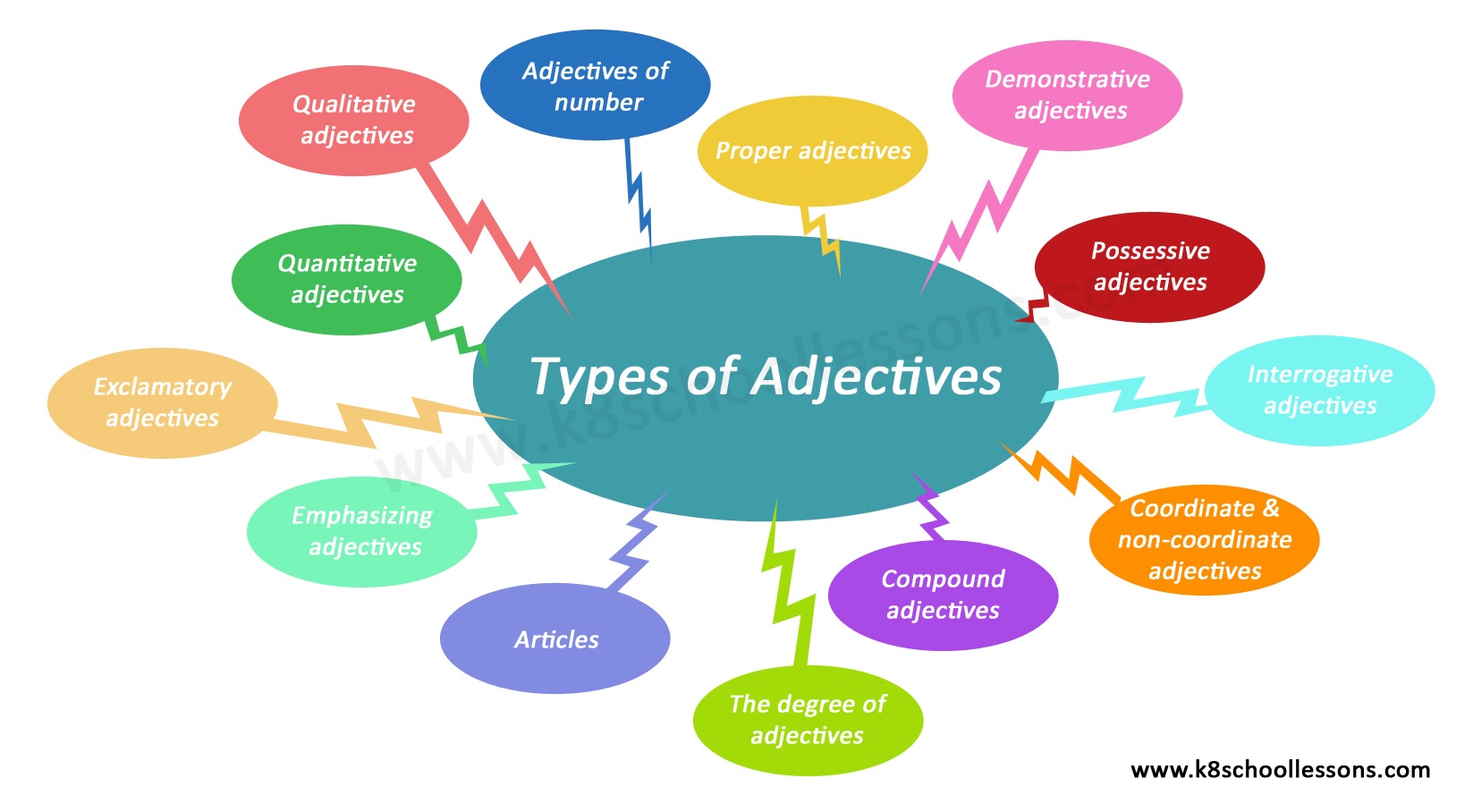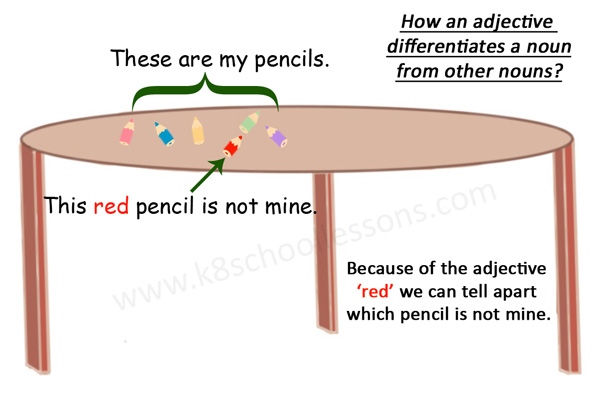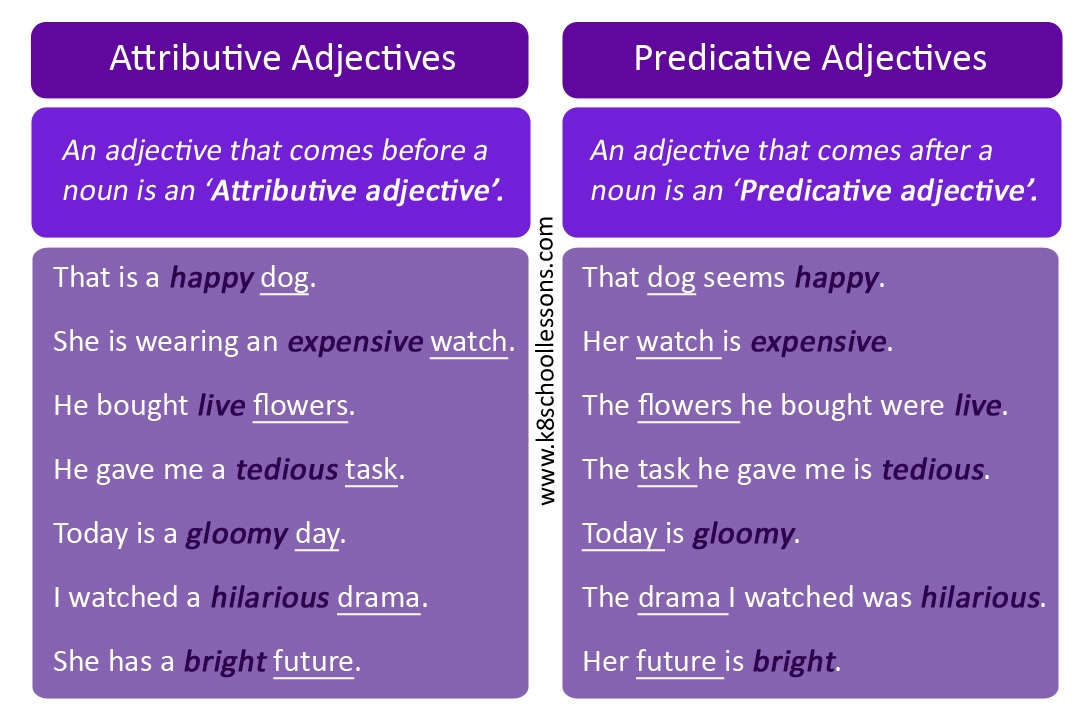Types of Adjectives
In this lesson we’re going to learn about adjectives definition, which means what adjective are, types of adjectives and many examples of adjectives.

Adjectives Definition
Adjectives describe nouns and pronouns in a sentence or in other words adjectives modify nouns and pronouns.
Adjectives define characteristics of nouns and pronouns such as appearance, colour, size, shape, personality, feelings, conditions etc. In this way adjectives differentiate nouns and pronouns from one another.
Example:
The red pencil on the table is not mine.
Here, ‘red’ describes the noun, ‘pencil’, which doesn’t belong to me. By using ‘red’ I could differentiate the pencil, which is not mine from the other pencils on the same table. Therefore, ‘red’ is the adjective of the sentence.

Attributive and Predicative Adjectives
Adjectives can come either before or after a noun.
An adjective that comes before a noun is an ‘Attributive adjective’.
Example:
The blue sky. – Here, the adjective ‘blue’ comes before the noun, ‘sky’. Therefore, it is an ‘attributive adjective’.
An adjective that comes after a noun is a ‘Predicative adjective’.
Example:
The sky is blue. – Here, the adjective ‘blue’ comes after the noun, ‘sky’. Therefore, it is a ‘predicative adjective’.
Look at the following examples. There can be more than one adjective in a sentence. The words in bold are the adjectives of each sentence.
- Jo has an elegant mustang.
- Kina is a stubborn girl.
- Flora has a green kite.
- Simon has $50 note in his wallet.
- This school has three buildings.
- I have finished most of the work.
- My sister loves Gucci perfume.
- Those were bad mangoes.
- Her handwriting is neat.
- What is that huge thing over there?
- He is a well-behaved boy.
- She gave me a “get out now” look.
- An orange is not always orange in colour.
- I want to see it with my own eyes.

All these adjectives can be grouped into different types of adjectives.
Types of adjectives
- Qualitative adjectives (Adjectives of quality or Descriptive adjectives)
- Quantitative adjectives (Adjectives of quantity)
- Adjectives of number (Definite numeral adjectives/ Indefinite numeral adjectives/ Distributive numeral adjectives)
- Proper adjectives
- Demonstrative adjectives
- Possessive adjectives
- Interrogative adjectives
- Coordinate adjectives and Non-coordinate adjectives
- Compound adjectives
- The degree of adjectives – positive, comparative, superlative
- Articles
- Emphasizing adjectives
- Exclamatory adjectives
Qualitative adjectives
Qualitative adjectives are also called adjectives of quality or descriptive adjectives. These adjectives describe the quality or nature of the noun or pronoun by giving an idea about the characteristics of the noun or pronoun, such as appearance, positive or negative personality, colour, shape, size, time, sound, touch, taste, condition etc.
Look at the following examples of adjectives of quality or qualitative adjectives or descriptive adjectives.
- Jo has an elegant mustang. – The adjective ‘elegant’ describes the appearance of the noun ‘mustang’.
- She has a charming personality. – The adjective ‘charming’describes the positive personality of the pronoun ‘she’.
- Sophie is a stubborn girl. – The adjective ‘stubborn’ describes the negative personality of the noun ‘Sophie’.
- Flora has a green kite. – The adjective ‘green’ describes the colour of the noun ‘kite’.
- Edgar is a chubby boy. – The adjective ‘chubby’ describes the shape of the noun ‘Edgar’.
- Mr. Wayne owns a massive house. – The adjective ‘massive’ describes the size of the noun ‘house’.
- Ancient Egyptians were skilled craftsmen. – The adjective ‘ancient’ describes the time that the noun ‘Egyptians’ belongs to.
- I heard a faint voice when I walked past the shed. – The adjective ‘faint’ describes the sound of the noun ‘voice’.
- She has soft skin. – The adjective ‘soft’ describes the touch of the noun ‘skin’.
- I’m going to make a savory snack for tea today. – The adjective ‘savory’ describes the taste of the noun ‘snack’.
- The meat was not tender enough to eat. – The adjective ‘tender’ describes the condition of the noun ‘meat’.
Quantitative adjectives
Quantitative adjectives are also called adjectives of quantity. Quantitative adjectives or adjectives of quantity are used with uncountable nouns. They show an approximate amount of the noun or pronoun. So, we can ask questions with ‘how much’.
Look at the following examples of quantitative adjectives or adjectives of quantity. Each sentence talks about an approximate amount of something, but not the exact amount.
- Christina ate some pasta. – How much pasta did Christina eat?
- Rita has no qualification for this job. – How much qualification does Rita have for this job?
- We have enough fuel in the tank. – How much fuel we have in the tank?
- He will donate all his money. – How much money will he donate?
- I have finished most of the work. – How much work have you finished?
- We don’t have any butter left. – How much butter do we have left?
- Julian spent a few bucks for shopping. – How much money did Julian spend for shopping?
- We don’t have much time. – How much time do we have?
- We have little milk in the fridge. – How much milk do we have in the fridge?
- He has sufficient computer skills. – How much computer skills does he have?
- Casey ate the whole banana. – How much of the banana did Casey eat?
In some cases, adjectives of quantity such as some, no, enough, all, most, any, few etc. are used with countable nouns too. Then these adjectives will become ‘indefinite numeral adjectives’ and the questions should be asked with ‘how many’. We will discuss this in the next type of adjectives.
Adjectives of number
Adjectives of number are used with countable nouns. They show the exact number of the noun or pronoun. So, we can ask questions with ‘how many’.
Adjectives of number can be classified into different groups. They are;
- Definite numeral adjectives
- Indefinite numeral adjectives
- Distributive numeral adjectives
Definite numeral adjectives
Definite numeral adjectives describe the exact number of nouns, and also their place in a certain order. Cardinal numbers (one, two three etc.) are used to denote the exact number of nouns or pronouns whereas ordinal numbers (first, second, third etc.) are used to denote the position of the nouns or pronouns in a certain order.
Look at the following examples of definite numeral adjectives.
- Only twenty students are going to the summer camp. – Use of cardinal numbers as definite numeral adjectives
- Margie ate three slices of pizza. – Use of cardinal numbers as definite numeral adjectives
- Norman became the third in the race. – Use of ordinal numbers as definite numeral adjectives
- Kina wants to be the first in the class. – Use of ordinal numbers as definite numeral adjectives
Indefinite numeral adjectives
Indefinite numeral adjectives denote an approximate amount of countable nouns, instead of the exact number. So, we can ask questions with ‘how many’. Some, many, few, several, no, enough, all, most, any are some examples of indefinite numeral adjectives. Some of these adjectives are also used as ‘quantitative adjectives or adjectives of quantity’, which we have already learnt above.
Look at the following examples of indefinite numeral adjectives.
- I have some pens in my bag. – How many pens do you have in your bag?
- There were many parents in the meeting. – How many parents were there in the meeting?
- There are a few apples in the basket. – How many apples are there in the basket?
- Several protesters were arrested. – How many protesters were arrested?
- David has no blue shirts. – How many blue shirts does David have?
- We have enough pillows. – How many pillows do we have?
- Peter gave all his books. – How many books did Peter give?
- Most of the pencils are blue. – How many pencils are blue?
- We don’t have any mangoes for the fruit salad. – How many mangoes do we have for the fruit salad?
Distributive numeral adjectives
Distributive numeral adjectives refer to singular number of nouns within the whole amount. Every, each, either, neither, another and other are some examples of distributive numeral adjectives.
Look at the following examples of distributive numeral adjectives.
- Every child is special.
- Each team gets a different task.
- You can either wait or leave.
- He is neither a doctor nor a pharmacist.
- You can have another cookie if you beave well.
- Who is the other man sitting next to her?
If you carefully look at these examples, you can notice that each distributive numeral adjective is followed by a singular noun and a verb.
However, if you use the word ‘of’ immediately after a distributive numeral adjective, make sure to use the plural noun instead.
Examples:
- Every one of them has to sign the petition.
- Each of the boys must meet the principal.
- Either of us has to go to the mall.
- Neither of the ways is correct.
Proper adjectives
We know that a proper noun is a name given to a person, place, or thing to make the noun more specific and it always begins with a capital letter. For example; Jane, Melbourne, January, Friday etc.
When these proper nouns describe other nouns or pronouns, then they become ‘proper adjectives’.
Look at the following table of proper nouns and their proper adjectives.
|
Proper Noun |
Proper adjective |
|
Australia |
Australian |
|
America |
American |
|
Europe |
European |
|
Shakespeare |
Shakespearean |
|
Christianity |
Christian |
|
Buddhism |
Buddhist |
Now look at the following examples of proper adjectives.
- Japanese cars are durable.
- Philip Island is an Australian island.
- Romeo and Juliet is a popular Shakespearean tragedy.
- They are Buddhist devotees.
- Anna loves Italian cuisine.
Demonstrative adjectives
A demonstrative adjective modifies a noun or pronoun by its position as near or far or in time. This, that, these, and those are examples of demonstrative adjectives. ‘This’ and ‘that’ modify singular nouns while ‘these’ and ‘those’ modify plural nouns. Also, ‘this’ and ‘these’ modify nouns which are near or present at the moment whereas ‘that’ and ‘those’ modify nouns which are farther away or existed in the past. A demonstrative adjective can always be seen before a noun.
Look at the following examples of demonstrative adjectives.
- This shirt is dirty. – The adjective ‘this’ talks about the singular noun ‘shirt’ which is near and present at the moment.
- That man is suspicious. – The adjective ‘that’ talks about the singular noun ‘man’ who is far and present at the moment. Identify the time with the auxiliary verb ‘is’.
- That cat was funny. – The adjective ‘that’ talks about the singular noun ‘cat’ which existed in the past. Identify the time with the auxiliary verb ‘was’.
- These mangoes are sweet. – The adjective ‘these’ talks about the plural noun ‘mangoes’ which are near and present at the moment.
- Those buildings are tall. – The adjective ‘those’ talks about the plural noun ‘buildings’ which are far and present at the moment. Identify the time with the auxiliary verb ‘are’.
- Those apartments were expensive. – The adjective ‘those’ talks about the plural noun ‘apartments’ which were present in the past. Identify the time with the auxiliary verb ‘were’.
Please note ‘demonstrative adjectives’ are different from ‘demonstrative pronouns’ as demonstrative pronouns do not modify nouns or pronouns.
Examples of demonstrative pronouns
- What is that?
- This tastes bad.
- These make me crazy.
- Tell him not to touch those.
Possessive adjectives
Possessive nouns show the ownership of something to someone or something. My, his, her, your, our, and their are some examples of possessive adjectives. Possessive adjectives are followed by nouns.
Look at the following examples of possessive adjectives.
- My hair is black. – The adjective ‘my’ is followed by the noun ‘hair’.
- His car is brand-new. – The adjective ‘his’ is followed by the noun ‘car’.
- Her voice is rough. – The adjective ‘her’ is followed by the noun ‘voice’.
- Your cat is cute. – The adjective ‘your’ is followed by the noun ‘cat’.
- Our house is old. – The adjective ‘our’ is followed by the noun ‘house’.
- Their performance was amazing. – The adjective ‘their’ is followed by the noun ‘performance’.
Interrogative adjectives
Interrogative adjectives ask questions. Examples of interrogative adjectives are ‘which’, ‘what’ and ‘whose’. An interrogative adjective is always followed by a noun or a pronoun. These words will not be interrogative adjectives if a noun or pronoun does not follow them.
Look at the following examples of interrogative adjectives.
- Which dress are you going to wear?
- What subject will you choose?
- Whose money is this?
Coordinate adjectives and Non-coordinate adjectives
Coordinate adjectives
Coordinate adjectives describe a series of attributes of the same noun or pronoun. The attributes must be separated by commas to avoid confusions when reading the sentence.
Look at the following examples of how to use coordinate adjectives.
- It is a happy, playful, energetic, cute puppy.
- It is a happy, playful, energetic and cute puppy.
OR
Non-coordinate adjectives
These adjectives in the series neither use commas nor the conjunction ‘and’ to separate the adjectives, or else the sentence does not make sense.
Look at the following examples of how to use non-coordinate adjectives.
- I have two synthetic leather bags. (Correct)
- I have two synthetic, leather bags. (Wrong and doesn’t make sense)
- I have two synthetic and leather bags. (Wrong and doesn’t make sense)
Compound adjectives
Compound nouns or words separated by a hyphen or joined together by quotation marks that modify other nouns or pronouns are called compound adjectives.
Look at the examples of compound adjectives.
- I had an ice-cream sandwich for dessert.
- Bob has a second-hand car.
- He is a well-known teacher.
- Tom finally found a part-time job.
- It was a heart-breaking movie.
- She gave me a “get out now” look.
The degree of adjectives
Positive, Comparative, and Superlative are the three degrees of adjectives.
Comparative and superlative forms of adjectives are used when comparing two or more nouns using adjectives.
Look at the following examples.
- Today is a bad day. (Positive degree)
- Today is worse than yesterday. (Comparative degree)
- Today is the worst day in my life. (Superlative degree)
- Amie is tall. (Positive degree)
- Sami is taller than Amie. (Comparative degree)
- Jimmy is the tallest. (Superlative degree)
Articles
‘The’, ‘a’ and ‘an’ are articles. Articles modify nouns. ‘The’ modifies specific nouns whereas ‘a’ and ‘an’ modify non-specific nouns.
Look at the following examples.
- The dog fetched the bone. – Here the noun ‘dog’ refers to a specific dog.
- A dog always likes its bone. – Here the noun ‘dog’ refers to any dog. It’s not a specific dog.
- There is an elephant near the lake. – Here the noun ‘elephant’ refers to any elephant. It’s not a specific elephant.
Emphasizing adjectives
‘Own’ and ‘very’ are examples of emphasizing adjectives. ‘Own’ is usually used to emphasize possessive adjectives.
Look at the following examples of how to use ‘own’ as an emphasizing adjective.
- Mind your own business.
- I will bring my own lunch.
- This is her own house.
- I run my own business.
- He made the whole structure with his own hands.
Look at the following examples of how to use ‘very’ as an emphasizing adjective.
- Today is the very first day of her job.
- This is the very house that I have always been dreaming of.
- I couldn’t believe what happened before my very eyes.
- James bought the very car that his son wanted to buy.
- That very watch I wanted buy was already sold.
Exclamatory Adjectives
Exclamatory adjectives are used to show emotions. ‘What’ and ‘how’ are usually used as exclamatory adjectives as they are often used to express strong emotions and surprises. ‘What’ is also an interrogative adjective. The exclamation mark, ‘!’ is used at the end of a sentence with an exclamatory adjective.
Look at the following examples of exclamatory adjectives.
- What a picturesque view!
- What a beautiful ranch house!
- What a brilliant presentation!
- What nonsense!
- What kind-hearted people they are!
- What beautiful weather it is!
- How dangerous it is!
- How thoughtful you are!
- How bad you are!